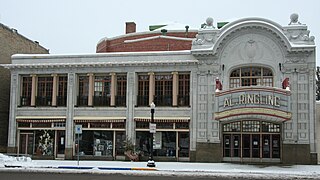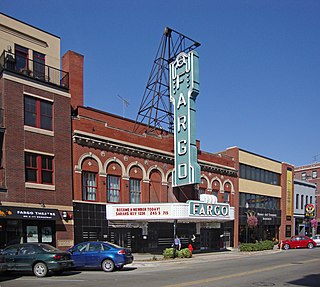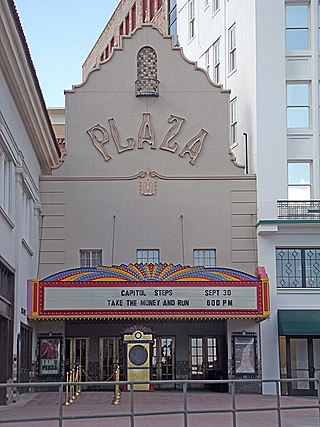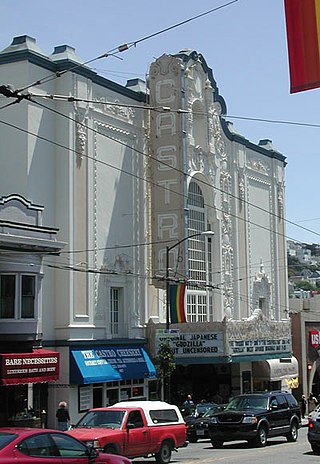
The Castro Theatre is a historic movie palace in the Castro District of San Francisco, California. The venue became San Francisco Historic Landmark #100 in September 1976. Located at 429 Castro Street, it was built in 1922 with a California Churrigueresque façade that pays homage—in its great arched central window surmounted by a scrolling pediment framing a niche—to the basilica of Mission Dolores nearby. Its designer, Timothy L. Pflueger, also designed Oakland's Paramount Theater and other movie theaters in California during that period. The theater has more than 1,400 seats.

The Tennessee Theatre is a movie palace in downtown Knoxville, Tennessee. The theater was built in 1928 in the 1908 Burwell Building, considered Knoxville's first skyscraper. The theater and Burwell Building were added to the National Register of Historic Places in 1982, and the theater was extensively restored in the early 2000s. The Tennessee Theatre currently focuses on hosting performing arts events and classic films, and is home to the Knoxville Opera and the Knoxville Symphony Orchestra. The theater is managed by AC Entertainment.

The Alabama Theatre is a movie palace in Birmingham, Alabama. It was built in 1927 by Paramount's Publix Theatres chain as its flagship theater for the southeastern region of the United States. Seating 2,500 people at the time, it was the largest in the Birmingham theater district. The district was once home to many large theaters and movie palaces that featured vaudeville, performing arts, nickelodeons and Hollywood films. Built to show silent films, the Alabama still features its original Wurlitzer theater organ. The Alabama Theatre and Lyric Theatre are the district's only remaining theaters, and as of 2024, both are in operation.

The Kings Theatre, formerly Loew's Kings Theatre, is a live performance venue in the Flatbush neighborhood of Brooklyn, New York City. Opened by Loew's Theatres as a movie palace in 1929 and closed in 1977, the theater sat empty for decades until a complete renovation was initiated in 2010. The theater reopened to the public on January 23, 2015 as a performing arts venue. It was listed on the National Register of Historic Places on August 22, 2012.

The Byrd Theatre is a cinema in the Carytown neighborhood of Richmond, Virginia. It was named after William Byrd II, the founder of the city. The theater opened on December 24, 1928 to much excitement and is affectionately referred to as "Richmond’s Movie Palace". Though equipped with a Wurlitzer pipe organ, the theatre was also one of the first of its kind to be originally outfitted for sound motion pictures.

The Loew's Jersey Theatre is a theater in Jersey City, New Jersey. Opened in 1929, it was one of the five Loew's Wonder Theatres, a series of flagship Loew's movie palaces in the New York City area. It was designed by the architectural firm of Rapp and Rapp in a Baroque/Rococo style. Tri-plexed in 1974, and then closed in 1986, it was dark for years. It was purchased by the city in 1993 and has been operated by a volunteer organization, the Friends of the Loews, since that time. The theater was designated as a New Jersey Registered Historic Site in 2009. In a move opposed by Friends of the Loews, the city in June 2014, agreed to let AEG Live operate the venue. After going to court, the lease by Friends of the Loews remains in effect. In 2022, a $72 million restoration project was started by Devils Arena Entertainment, a division of Harris Blitzer Sports & Entertainment that operates the Prudential Center, with completion being expected by 2025.

Shea's Performing Arts Center is a theater for touring Broadway musicals and special events in Buffalo, New York. Originally called Shea's Buffalo, it was opened in 1926 to show silent movies. It took one year to build the entire theatre. Shea's boasts one of the few theater organs in the US that is still in operation in the theater for which it was designed.

The Al. Ringling Theatre in Baraboo, Wisconsin, United States, opened its doors in November 1915 and has been operating continuously ever since. Designed by the architectural firm Rapp and Rapp, it was built by Albert Ringling, one of the circus Ringling Brothers, for $100,000. Over the years, it has featured performances from vaudeville and silent movies to grand opera starring such notables as Lionel Barrymore and Mary Pickford.

The Chicago Theatre, originally known as the Balaban and Katz Chicago Theatre, is a landmark theater located on North State Street in the Loop area of Chicago, Illinois. Built in 1921, the Chicago Theatre was the flagship for the Balaban and Katz (B&K) group of theaters run by A. J. Balaban, his brother Barney Balaban and partner Sam Katz. Along with the other B&K theaters, from 1925 to 1945 the Chicago Theatre was a dominant movie theater enterprise. Currently, Madison Square Garden, Inc. owns and operates the Chicago Theatre as a 3600 seat performing arts venue for stage plays, magic shows, comedy, speeches, sporting events and popular music concerts.

The Paramount Theatre is a 2,807-seat performing arts venue located at 9th Avenue and Pine Street in the downtown core of Seattle, Washington, United States. The theater originally opened on March 1, 1928, as the Seattle Theatre, with 3,000 seats. It was placed on the National Register of Historic Places on October 9, 1974, and has also been designated a City of Seattle landmark.

The Fargo Theatre is an art deco movie theater in downtown Fargo, North Dakota, United States. Construction on the building began in the fall of 1925 and the theatre opened on March 15, 1926. It was restored in 1999 to its historic appearance and now is a center for the arts in the Fargo-Moorhead metropolitan area. The Fargo Theatre is home to a 4-manual, 32-rank Wurlitzer Theatre Pipe Organ, known as the "Mighty Wurlitzer," which is owned and maintained by the Red River Theatre Organ Society, a non-profit organization and local chapter of the American Theatre Organ Society.

The Orpheum Theatre, a 2,308-seat venue listed on the National Register of Historic Places, is located in downtown Memphis, Tennessee, on the southwest corner of the intersection of South Main and Beale streets. The Orpheum, along with the Halloran Centre for Performing Arts & Education, compose the Orpheum Theatre Group, a community-supported nonprofit corporation that operates and maintains the venues and presents education programs.

The Paramount Theatre is a concert venue in Denver, Colorado, located on Glenarm Place, near Denver's famous 16th Street Mall. The venue has a seating capacity of 1,870 but is a popular destination for large acts looking for a smaller concert setting. With spelling as Paramount Theater, the building was listed on the National Register of Historic Places in 1980.

The Plaza Theatre is a historic building in El Paso, Texas built in 1930. The theater stands as one of the city's most well-known landmarks, and remains operational today. The theatre is a National Historic Building of Significance featuring the 2,050-seat Kendall Kidd Performance Hall, and the smaller 200-seat Philanthropy Theatre. It hosts Broadway productions, musical concerts, individual performers and the annual Plaza Classic Film Festival.

The Riviera Theatre is a historic, 1140 seat entertainment venue in North Tonawanda, New York. The theatre hosts live concerts, theatre, dance shows, and movies. The Riviera's “Mighty Wurlitzer” theatre organ has been restored, is maintained by volunteers, and is famed as being one of two original Wurlitzer demonstrator organs, which the company would use to show off to potential clients in the height of the silent film era.

The Orpheum Theatre, also known as New Orpheum Theatre and Orpheum Electric Building, is a performing arts center located at 528 S. Pierce Street in Sioux City, Iowa. Built in 1927 as a vaudeville and movie palace, the theatre was restored in 1999 and today is the home of the Sioux City Symphony Orchestra.

The Kahl Building is a historic building located in Downtown Davenport, Iowa, United States. It was listed on the National Register of Historic Places in 1983. In 2020 it was included as a contributing property in the Davenport Downtown Commercial Historic District. The building also includes the Capitol Theatre.

The Tivoli Theatre, also known as the Tivoli and the "Jewel of the South", is a historic theatre in Chattanooga, Tennessee, that opened on March 19, 1921. Built between 1919 and 1921 at a cost of $750,000, designed by famed Chicago-based architectural firm Rapp and Rapp and well-known Chattanooga architect Reuben H. Hunt, and constructed by the John Parks Company, the theatre was one of the first air-conditioned public buildings in the United States. The theatre was named Tivoli after Tivoli, Italy, has cream tiles and beige terra-cotta bricks, has a large red, black, and white marquee with 1,000 chaser lights, and has a large black neon sign that displays TIVOLI with still more chaser lights.

The Castro Organ Devotees Association (CODA) is an American nonprofit organization dedicated to preserving and enhancing the tradition of live organ music in San Francisco's Castro Theatre. The theater is a popular San Francisco movie palace, built in the 1920s, which gained Historic Landmark status in 1976. The original Robert Morton organ was removed in the 1950s. The present organ, widely regarded as one of the finest theatre organs assembled, was assembled in the late 1970s using components from other organs, including its console, which was originally built in 1925 for the State Theatre in Detroit, Michigan to accompany silent pictures. The current console and organ were built by the Taylor family starting in 1979, and it has been owned and maintained by them since, but in 2014 they moved taking the console and one fourth of the pipework.

The Senate Theater is a theater in Detroit, Michigan, known for its "Mighty Wurlitzer" pipe organ, originally installed at the Fisher Theater. The Senate opened in 1926, deteriorated substantially after its closure in the 1950s, and reopened in 1964 under the ownership and volunteer operation of the Detroit Theatre Organ Society. The Senate continues to present organ performances, classic films, and private events.
























